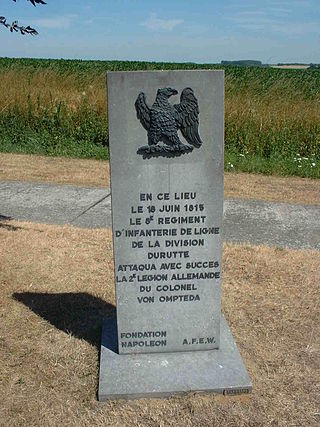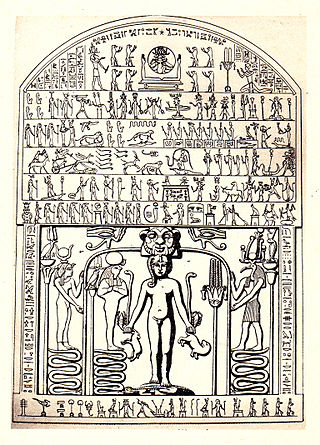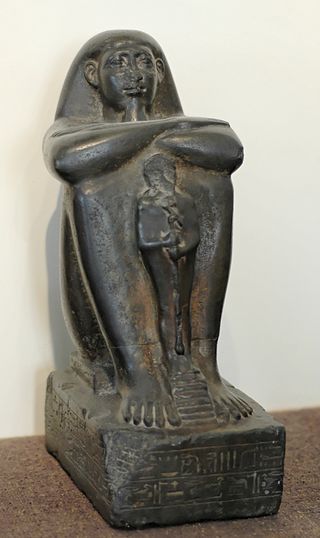
Seshat was the ancient Egyptian goddess of writing, wisdom, and knowledge. She was the daughter of Thoth. She was seen as a scribe and record keeper; her name means "female scribe". She is credited with inventing writing. She also became identified as the goddess of sciences, accounting, architecture, astronomy, astrology, building, mathematics, and surveying.
The Amduat[pronunciation?] is an important ancient Egyptian funerary text of the New Kingdom of Egypt. Similar to previous funerary texts, such as the Old Kingdom's Pyramid Texts, or the First Intermediate Period's Coffin Texts, the Amduat was found carved on the internal walls of a pharaoh's tomb. Unlike other funerary texts, however, it was reserved almost exclusively for pharaohs until the Twenty-first Dynasty, or very select nobility.
The djed, also djt is one of the more ancient and commonly found symbols in ancient Egyptian religion. It is a pillar-like symbol in Egyptian hieroglyphs representing stability. It is associated with the creator god Ptah and Osiris, the Egyptian god of the afterlife, the underworld, and the dead. It is commonly understood to represent his spine.

A stele, from Greek στήλη, stēlē, plural στήλαι stēlai, is a stone or wooden slab, generally taller than it is wide, erected in the ancient world as a monument. The surface of the stele often has text, ornamentation, or both. These may be inscribed, carved in relief, or painted.

Deshret was the Red Crown of Lower Egypt. It was red bowl shaped with a protruding curlicue. When combined with the Hedjet of Upper Egypt, it forms the Pschent, in ancient Egyptian called the sekhemti.

The Metternich Stela is a magico-medical Horus on the Crocodiles stele that is part of the Egyptian collection of the Metropolitan Museum of Art in New York City. It dates to the Thirtieth Dynasty of Egypt around 380–342 B.C. during the reign of Nectanebo II. The provenance of the stele is unknown.

The block statue is a type of memorial statue that first emerged in the Middle Kingdom of Egypt. The block statue grew in popularity in the New Kingdom and the Third Intermediate Period, and by the Late Period, this type of statue was the most common. These statues were used in temples typically as funerary monuments of non-royal yet important individuals. According to primary sources from the New Kingdom, the posture of the statue was possibly intended to resemble a guardian seated in the gateway of a temple. In addition, their simple shape provided ample flat surfaces for inscriptions of offerings and invocations.
This is a glossary of ancient Egypt artifacts.

In art and archaeology, sculpture and painting, a register is a horizontal level in a work that consists of several levels arranged one above the other, especially where the levels are clearly separated by lines. Modern comic books typically use similar conventions. It is thus comparable to a row, or a line in modern texts. In the study of ancient writing, such as cuneiform and Egyptian hieroglyphs, "register" may be used of vertical compartments like columns containing writing that are arranged side by side and separated by lines, especially in cylinder seals, which often mix text and images. Normally, when dealing with images it only refers to row compartments stacked vertically.

The Book of the Earth is an Ancient Egyptian funerary text that has been called many names such as The Creation of the Sun Disk and the Book of Aker. The Book primarily appears on the tombs of Merneptah, Twosret, Ramesses III, Ramesses VI, and Ramesses VII and serves as a counterpart to the Book of Caverns.
The Foreleg of ox hieroglyph of ancient Egypt is a hieroglyph; it is the nighttime constellation Ursa Major called as Maskheti constellation. It came to have many uses in ancient Egypt over its entire history.
The ancient Egyptian Papyrus stem hieroglyph is one of the oldest language hieroglyphs from Ancient Egypt. The papyrus stalk, was incorporated into designs of columns on buildings, also facades, and is also in the iconographic art portrayed in ancient Egyptian decorated scenes.

The Min Palette, or El Amrah Palette is an ancient Egyptian cosmetic palette from El-Amrah, Egypt, found in Naqada, tomb B62. It is held in the British Museum, no. 35501.

The pectorals of ancient Egypt were a form of jewelry, often in the form of a brooch. They are often also amulets, and may be so described. They were mostly worn by richer people and the pharaoh.

The Decree of Nectanebo I was issued by Pharaoh Nectanebo I of the 30th Dynasty of Ancient Egypt. It regards payments to the local temple, and was recorded on two steles.

Frosting is a decorative effect named after its resemblance to the appearance of frost. It involves making very small marks in a surface so that it appears matt rather than polished, and in glass opaque rather than optically transparent. It is often used for glass for bathrooms and toilets, but may be used on many materials and created by many processes.
The Paser Crossword Stela is an ancient Egyptian limestone stela that dates from the 20th Dynasty. It was constructed by Paser, c. 1150 BC, during the reign of Pharaoh Ramesses VI.
The ancient Egyptian Branch hieroglyph, also called a Stick, is a member of the trees and plants hieroglyphs.

In ancient Egyptian art, the Set animal, or sha, is the totemic animal of the god Set. Because Set was identified with the Greek monster Typhon, the animal is also commonly known as the Typhonian animal or Typhonic beast.
The ancient Egyptian Papyrus roll-tied and sealed hieroglyph comes in the common horizontal, or a vertical form. It is juxtaposed against an open scroll, the Papyrus roll-open hieroglyph,



















